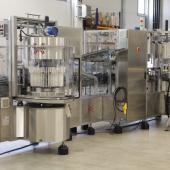Digitisation: what’s in store?
Analysis of available technologies and development prospects, when the models of artificial intelligence and industrial automation will be increasingly interconnected and interdependent. Powered by data acquired from the field in real time and data produced by intelligent models and simulators, they will implement processes by means of cyber-physical systems.
Danilo Mascolo, BI-REX (Bologna, Italy)
The pervasive capacity of digitisation, fuelled by rapid advances in technology, is transforming the way we live, work and communicate, by profoundly changing how we interact with the world around us. We are witnesses, and increasingly protagonists, of an era in which digital technologies are being integrated into traditional production resources, putting data and its exploitation at the heart of processes, and working in conjunction more traditional systems to create goods, products and services. The transformation is involving all sectors indiscriminately (including the most traditional, craft-based trades), thus opening up new opportunities for creativity and artistic expression.
Substantial private investment - backed up by state tax incentives - and technological experimentation are turning into new organizational models in which Information and Communication Technology merges with Operation Technology and the organisation of work. This is spawning ever smarter and more adaptive new processes and production scenarios, which were the stuff of dreams until just a few years ago. This is possible because technologies build upon each other exponentially like individual bricks in complex architectures.
In these complex architectures, and against the constantly evolving backdrop of digitisation, all of the technologies involved in Industry 4.0 are making a contribution, in the same way that natural language processing models are playing a significant role in speeding up the transformation, by enabling a significant improvement in communication between people, computers and machines.
These models are capable of understanding, interpreting and generating text more and more accurately. They are bringing greater efficiency to information management, they are improving communication between individuals, and they are making it possible to create intelligent virtual assistants that provide immediate answers to users’ questions, by automating processes, analysing large amounts of textual data and providing tailored solutions to customers. These models have the ability to extract useful information from large volumes of text, enabling companies to gain valuable insights and make decisions based on the data generated by individuals and subject experts. This in turn strengthens the description of context and empowers models of hybrid intelligence in which machines can understand signals generated by protocols, thanks in part to the valuable linguistic contribution of experienced operators.
Using beyond-5G mobile technologies, the Internet of things and of processes is extending its reach, like an invisible grid connecting every aspect of our lives and production cycles, making every environment safer, more comfortable and more efficient, while helping achieve sustainability goals in line with the People, Planet, Profit principle.
Augmented, virtual and extended reality will make it possible to explore processes, assist customers and foster co-design processes across the entire value chain, thereby improving experiences, opening the doors to new forms of education and discovery, and renewing the processes of generating shared value.
Blockchain technology, with its immutable and decentralised structure, will usher in a new era of security, traceability and transparency, with a major impact on supply chains and data monetisation mechanisms, by facilitating secure transactions and reducing the risk of fraud and manipulation.
Collaborative robotics is set to become more and more mobile and autonomous. Interconnected with management systems, it will work alongside operators with experience in servomechanisms, quality control and a host of other functions, thus generating useful data for process improvement and producing quality reports in which process elements (such as production and resource consumption data) can be tracked in precise detail. Robotic arms can be programmed to form and manipulate shapes, so as to ensure precision and repeatability in machining. This not only reduces the manual workload, but also makes it possible to create complex shapes that are difficult to achieve entirely through human input.
And the heart of this digital revolution is made up of artificial intelligence models that not only optimise processes, but also process natural language to enable us to interact with the world of ones and zeros, in a similar way to how we interact with humans. Thanks to these generative models, we can communicate with processes, products and services, whether hosted by IT layers or on the shop-floor of operation technologies or serving customers naturally and intuitively. So we can offer and receive services and instant support, and we can answer questions to help operators, customers and suppliers solve problems quickly and accurately, while at the same time fuelling new creativity and cutting waiting times.
Artificial intelligence models, especially the ones based on machine learning, are already being used to improve design and manufacturing. By analysing data and learning from existing models, AI systems can generate unique new designs and patterns, giving designers an endless source of inspiration. These AI models can also suggest ways to optimise manufacturing processes, thereby improving quality and reducing waste.
But digitisation doesn’t end here. The future in store for us is a future in which models of artificial intelligence and industrial automation will be increasingly interconnected and interdependent. Powered by data acquired from the field in real time and data produced by intelligent models and simulators, they will implement processes by means of cyber-physical systems. Within this context, IT layers will provide work-task support and expert systems will fulfil the function of reliable assistants that understand needs and communicate with people. Time spent on repetitive tasks will be freed up, enabling organisations to shift their activities upstream and downstream of the value chain, namely towards Research & Development and the market, whose needs will be anticipated more and more effectively.
BI-REX is the Italian Competence Center specialised on Big Data, funded by the Italian Ministry of the Economic Development within the Industry 4.0 National Plan. It is a Public Private Partnership that gathers 60 players among Universities, Research Centers and Companies of excellence in order to support the adoption of Industry 4.0 technologies and support the technology transfer, through a varied series of services.


















